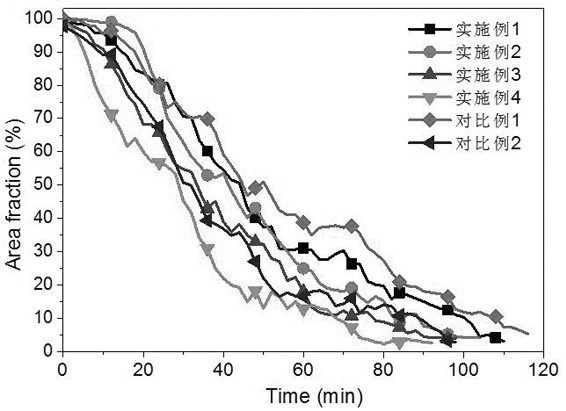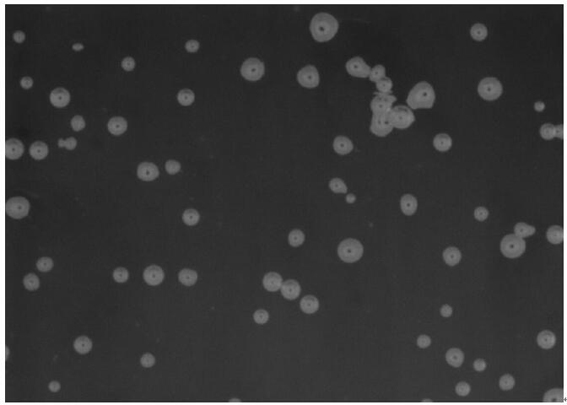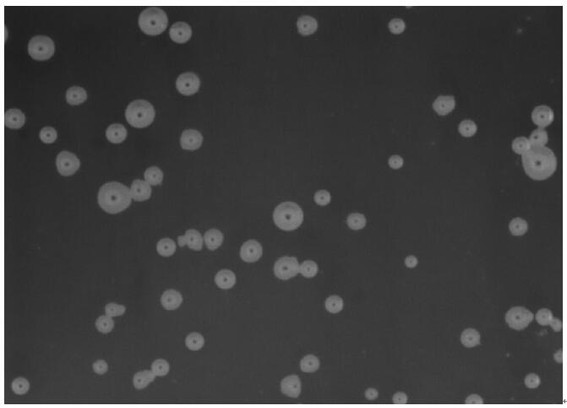Preparation method of alkali-free boroaluminosilicate glass
A boroaluminosilicate and glass technology, applied in glass manufacturing equipment, glass furnace equipment, manufacturing tools, etc., can solve the problems of poor flowability of batch materials, reduced optical properties of glass, difficulty in debubbling, etc., and achieves optical and thermodynamic properties. Improved performance, improved "dusting" effect, and the effect of glass clarification
- Summary
- Abstract
- Description
- Claims
- Application Information
AI Technical Summary
Problems solved by technology
Method used
Image
Examples
Embodiment 1
[0026] (1). Weigh the glass batch composed of the following weight percentage: 66% SiO 2 , 3% of B 2 o 3 , 16.5% Al 2 o 3 , 11% MgO, 2% CaO, 2% SrO, 0.2% ZrO 2 , 0.25% SnO and 0.05% In 2 o 3 , then add the glass batch material and water into the grinding jar filled with zirconia balls according to the mass ratio of 50:48, and grind for 0.5h; then add 1% PVA and 1% PEG, continue grinding for 2h;
[0027] (2) Put the ground slurry into the feeding trough of the spray granulator, adjust the air inlet temperature to 210°C, the blower frequency to 30HZ, and the induced fan frequency to 42HZ, and feed to prepare batch particles of 200μm;
[0028] (3) Add the prepared batch material particles into a kiln at 1500°C for 1 hour, and then raise the temperature to 1620°C for 3 hours. After the glass is clarified and homogenized, take out the glass liquid, carry out molding and annealing, and then prepare Alkali-free boroaluminosilicate glass.
Embodiment 2
[0030] (1). Weigh the glass batch composed of the following weight percentage: 66% SiO 2 , 3% of B 2 o 3 , 16.5% Al 2 o 3 , 11% MgO, 1% CaO, 2% SrO, 0.2% ZrO 2 , 0.25% SnO and 0.05% In 2 o 3 , then add the glass batch material and water into the grinding jar filled with zirconia balls at a mass ratio of 49:46, and grind for 0.5h; then add 2.5% of the total mass of the batch material and water into the grinding jar, respectively, 2.5% of PVA and 2.5% of the total mass of water PEG, continue grinding for 2h;
[0031] (2) Put the ground slurry into the feeding trough of the spray granulator, adjust the air inlet temperature to 210°C, the blower frequency to 30HZ, and the induced fan frequency to 42HZ, and feed to prepare batch particles of 150 μm;
[0032] (3) Add the prepared batch material particles into a kiln at 1500°C for 1 hour, and then raise the temperature to 1620°C for 3 hours. After the glass is clarified and homogenized, take out the glass liquid, carry out mol...
Embodiment 3
[0034] (1). Weigh the glass batch composed of the following weight percentage: 63% SiO 2 , 5% of B 2 o 3 , 14% Al 2 o 3 , 13% MgO, 1.5% CaO, 3% SrO, 0.2% ZrO 2 , 0.25% SnO and 0.05% In 2 o 3 , then add the glass batch material and water into the grinding jar filled with zirconia balls according to the mass ratio of 50:48, and grind for 0.5h; then add 1% PVA and 1% PEG, continue grinding for 2h;
[0035] (2) Put the ground slurry into the feeding trough of the spray granulator, adjust the air inlet temperature to 210°C, the blower frequency to 30HZ, and the induced fan frequency to 42HZ, and feed to prepare batch particles of 250 μm;
[0036] (3) Add the prepared batch material particles into a kiln at 1500°C for 1 hour, and then raise the temperature to 1620°C for 3 hours. After the glass is clarified and homogenized, take out the molten glass, carry out molding and annealing, and then prepare Alkali-free boroaluminosilicate glass.
PUM
 Login to View More
Login to View More Abstract
Description
Claims
Application Information
 Login to View More
Login to View More - R&D
- Intellectual Property
- Life Sciences
- Materials
- Tech Scout
- Unparalleled Data Quality
- Higher Quality Content
- 60% Fewer Hallucinations
Browse by: Latest US Patents, China's latest patents, Technical Efficacy Thesaurus, Application Domain, Technology Topic, Popular Technical Reports.
© 2025 PatSnap. All rights reserved.Legal|Privacy policy|Modern Slavery Act Transparency Statement|Sitemap|About US| Contact US: help@patsnap.com



